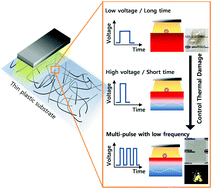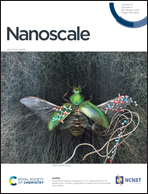Control of thermal deformation with photonic sintering of ultrathin nanowire transparent electrodes†
Abstract
Development of electronic devices on ultrathin flexible plastic substrates is of great value in terms of portability, cost reduction, and mechanical flexibility. However, because thin plastic substrates with low heat capacity can be more easily damaged by thermal energy, their use is limited. Highly flexible nanowire (NW) transparent conductive electrodes on ultrathin (∼10 μm) low cost polyethylene terephthalate (PET) substrates are fabricated. The control of intense pulsed light (IPL) irradiation process parameters to induce NW welding for maximum conductivity and minimal thermal damage of the PET substrate is explored. For this purpose, trends in temperature variation of NW thin films irradiated by IPL under various operating conditions are numerically analyzed using commercial software. Simulations indicate that irradiating light operated at a higher voltage and for a shorter time, and use of multiple pulses of low frequency can reduce thermal deformation of the PET substrate. Furthermore, we experimentally confirm that NW transparent electrodes can be successfully fabricated with less thermal deformation of the ultrathin plastic substrate when light is irradiated under well-controlled conditions derived from the simulation. The highly flexible NW transparent conducting electrode exhibits excellent mechanical flexibility to withstand severe deformation and can be successfully implemented in flexible organic light-emitting diodes (OLEDs).



 Please wait while we load your content...
Please wait while we load your content...